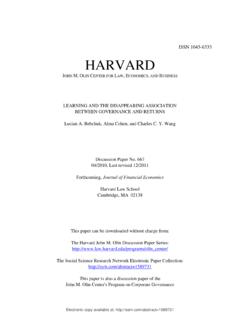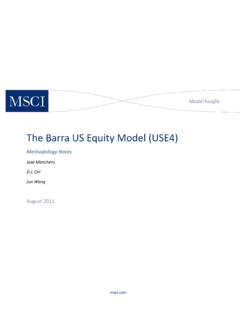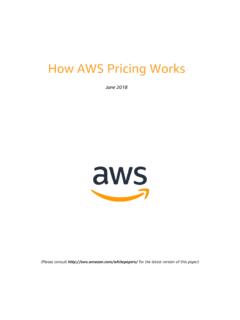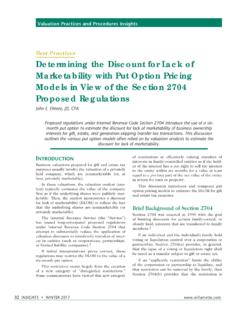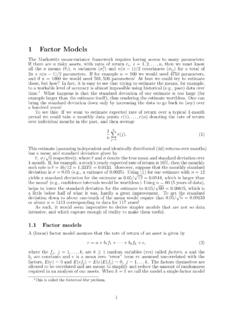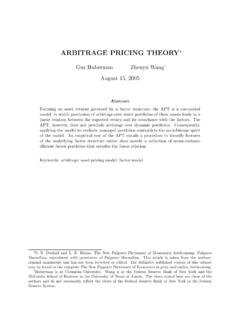Transcription of The Arbitrage Theory of Capital Asset Pricing
1 The Arbitrage Theory of Capital Asset Pricing STEPHEN A. ROSS* Departments of Economics and Finance, University of Pennsylvania, The Wharton School, Philadelphia, Pennsylvania 19174 Received March 19, 1973: revised May 19, 1976 The purpose of this paper is to examine rigorously the Arbitrage model of Capital Asset Pricing developed in Ross [13, 141. The Arbitrage model was proposed as an alternative to the mean variance Capital Asset Pricing model, introduced by Sharpe, Lintner, and Treynor, that has become the major analytic tool for explaining phenomena observed in Capital markets for risky assets. The principal relation that emerges from the mean variance model holds that for any Asset , i, its (ex ante) expected return Et = p + u, 3 (1) where p is the riskless rate of interest, X is the expected excess return on the market, E, - p, and is the beta coefficient on the market, where CJ,~~ is the variance of the market portfolio and 02 , is the covariance between the returns on the ith Asset and the market portfolio.]
2 (If a riskless Asset does not exist, p is the zero-beta return, , the return on all portfolios uncorrelated with the market portfolio.)l The linear relation in (1) arises from the mean variance efficiency of the market portfolio, but on theoretical grounds it is difficult to justify either the assumption of normality in returns (or local normality in Wiener diffusion models) or of quadratic preferences to guarantee such efficiency, and on empirical grounds the conclusions as well as the *Professor of Economics, University of Pennsylvania. This work was supported by a grant from the Rodney L. White Center for Financial Research at the University of Pennsylvania and by National Science Foundation Grant GS-35780.
3 1 See Black [2] for an analysis of the mean variance model in the absence of a riskless Asset . 341 Copyright !CI 1976 by Academic Press, Inc. All rights of reproduction in any form reserved. 342 STEPHEN A. ROSS assumptions of the Theory have also come under The restrictiveness of the assumptions that underlie the mean variance model have, however, long been recognized, but its tractability and the evident appeal of the linear relation between return, Ei , and risk, 6,) embodied in (1) have ensured its popularity. An alternative Theory of the Pricing of risky assets that retains many of the intuitive results of the original Theory was developed in Ross [13, 141.]
4 In its barest essentials the argument presented there is as follows. Suppose that the random returns on a subset of assets can be expressed by a simple factor model $ =z Ei + pig + ci , (2) where 8 is a mean zero common factor, and Ci is mean zero with the vector (z) sufficiently independent to permit the law of large numbers to hold. Neglecting the noise term, Ei , as discussed in Ross [14] (2) is a statement that the state space tableau of Asset returns lies in a two- dimensional space that can be spanned by a vector with elements 6,) (where 0 denotes the state of the world) and the constant vector, e cc (I,.., 1). Step 1. Form an Arbitrage portfolio, 7, of all the n assets, , a portfolio which uses no wealth, ne = 0.
5 We will also require n to be a well-diversified portfolio with each component, Q , of order l/n in (absolute) magnitude. Step 2. By the law of large numbers, for large II the return on the Arbitrage portfolio (3) In other words the influence on the well-diversified portfolio of the independent noise terms becomes negligible. Step 3. If we now also require that the Arbitrage portfolio, 7, be chosen so as to have no systematic risk, then and from (3) 2 See Blume and Friend [3 J for a recent example of some of the empirical difficulties faced by the mean variance model. For a good review of the theoretical and empirical literature on the mean variance model see Jensen [6].]
6 Capital Asset Pricing 343 Step 4. Using no wealth, the random return has now been engi- neered to be equivalent to a certain return, vE, hence to prevent arbitrarily large disequilibrium positions we must have = 0. Since this restriction must hold for all 17 such that ve =- VP -= 0, E is spanned by e and p or Ei = p + A,& (4) for constants p and X. Clearly if there is a riskless Asset , p must be its rate of return. Even if there is not such an Asset , p is the rate of return on all zero-beta portfolios, 01, , all portfolios with ale = 1 and L@ = 0. If 01 is a particular portfolio of interest, , the market portfolio, !x,,, , with E,,, = a,,$, (4) becomes Et = p + C-G,, - p) Pi.
7 (5) Condition (5) is the Arbitrage Theory equivalent of (1) and if 8 is a market factor return then & will approximate bi . The above approach, however, is substantially different from the usual mean-variance analysis and constitutes a related but quite distinct Theory . For one thing, the argument suggests that (5) holds not only in equilibrium situations. but in all but the most profound sort of disequilibria. For another, the market portfolio plays no special role. There are, however, some weak points in the heuristic argument. For example, as the number of assets, n, is increased, wealth will, in general, also increase. Increasing wealth, though, may increase the risk aversion of some economic agents.
8 The law of large numbers implies, in Step 2. that the noise term, +, becomes negligible for large n, but if the degree of risk aversion is increasing with n these two effects may cancel out and the presence of noise may persist as an influence on the Pricing relation. In Section I we will present an example of a market where this occurs. Furthermore, even if the noise term can be eliminated, it is not at all obvious that (5) must hold, since the disequilibrium position of one agent might be offset by the disequilibrium position of In Ross [13], however, it was shown that if (5) holds then it represents an E or quasi-equilibrium. The intent of this paper is to supply the rigorous analysis underlying the stronger stability arguments above.
9 In Section It we will present some weak sufficient conditions to rule out the above exceptions (and the example of Section I) and we will prove a general version of the Arbitrage result. Section 11 also includes a brief argument on the empirical practicality of the results. A mathematical appendix 3 Green has considered this point in a temporary equilibrium model. Essentialli he argues that if subjective anticipations differ too much, then Arbitrage possibilities will threaten the existence of equilibrium. 344 STEPHEN A. ROSS contains some supportive results of a somewhat technical and tangential nature. Section III will briefly summarize the paper and suggest further generalizations.
10 1. A COUNTEREXAMPLE In this section we will present an example of a market where the sequence of equilibrium Pricing relations does not approach the one predicted by the Arbitrage Theory as the number of assets is increased. The counterexample is valuable because it makes clear what sort of additional assumptions must be imposed to validate the Theory . Suppose that there is a riskless Asset and that risky assets are indepen- dently and normally distributed as where and 5i = Ei + E f , (6) E{q = 0, E(Q) = u2. The Arbitrage argument would imply that in equilibrium all of the independent risk would disappear and, therefore, Ei =s p, (7) Assume, however, that the market consists of a single agent with a von Neumann-Morgenstern utility function of the constant absolute risk aversion form, U(z) = -exp(--AZ).}
